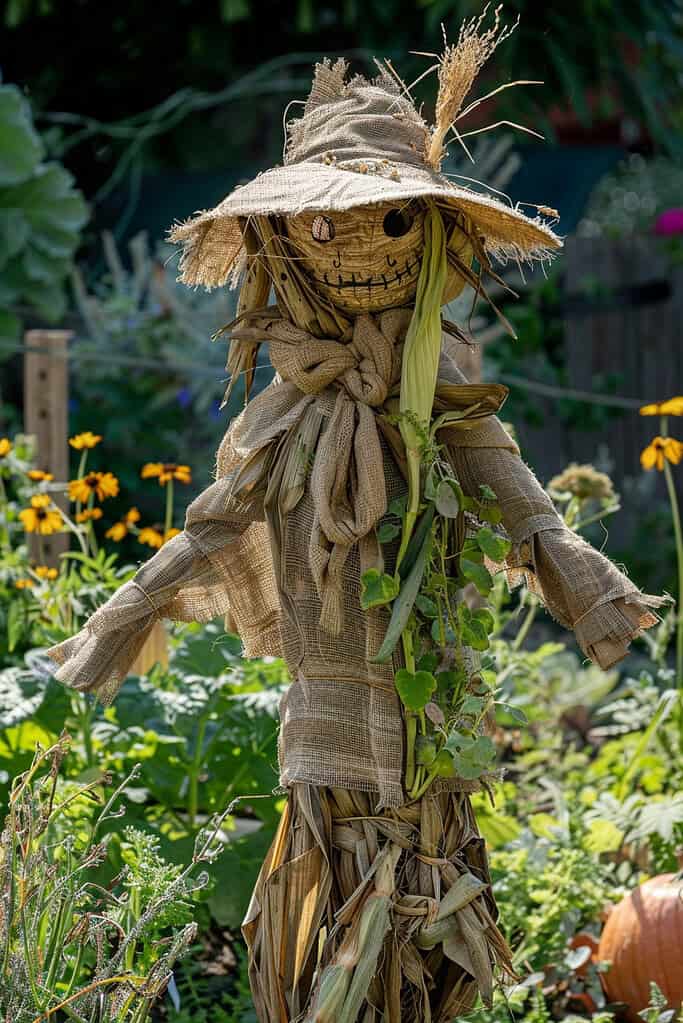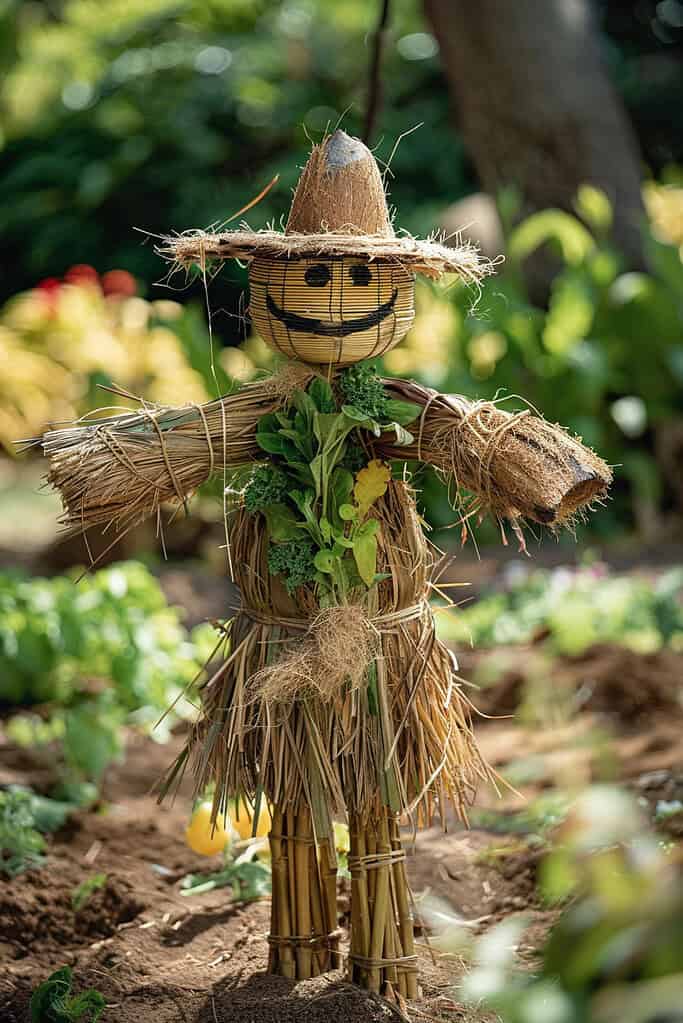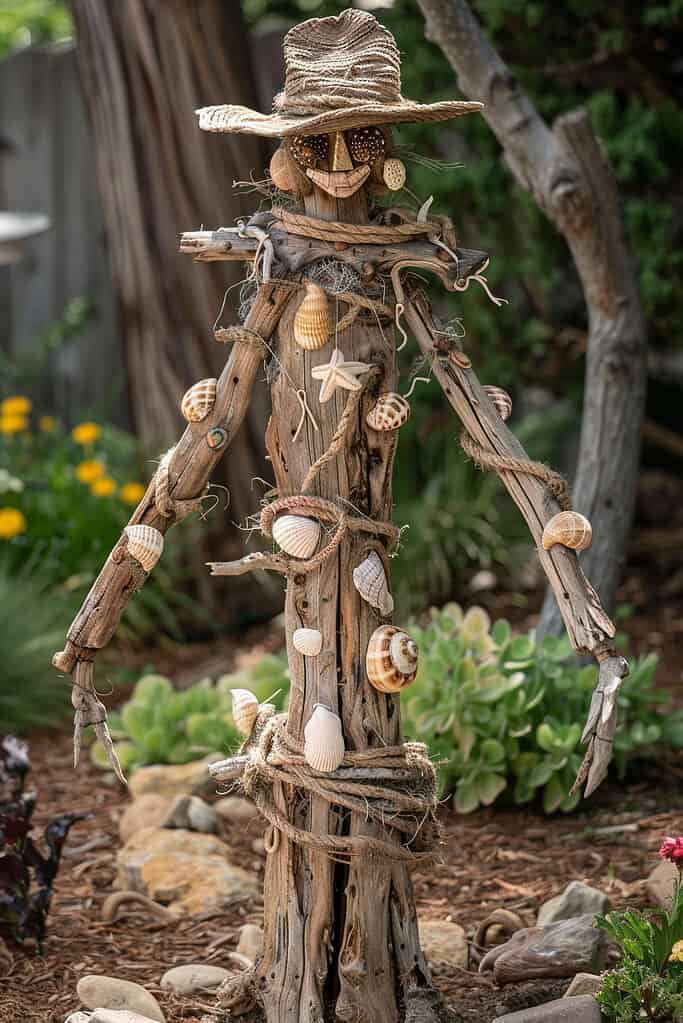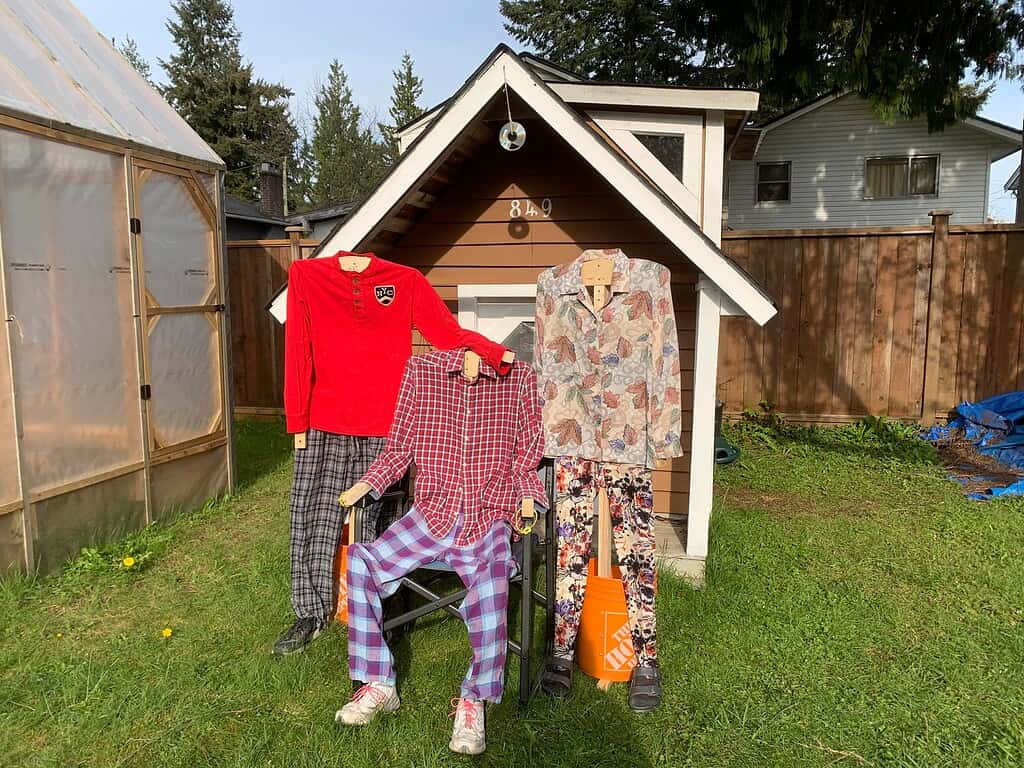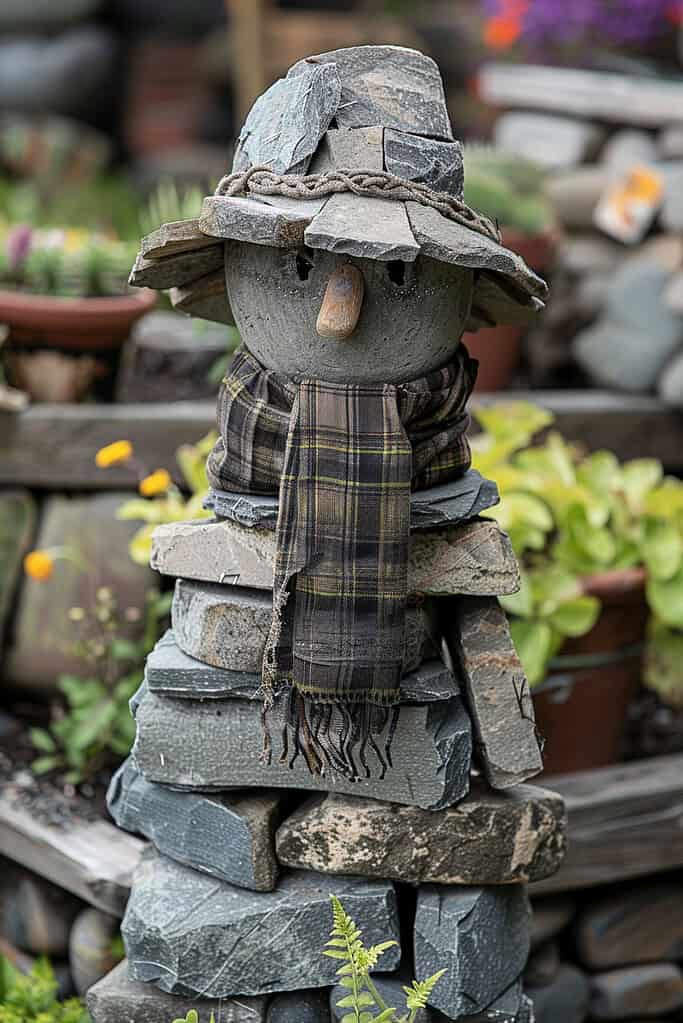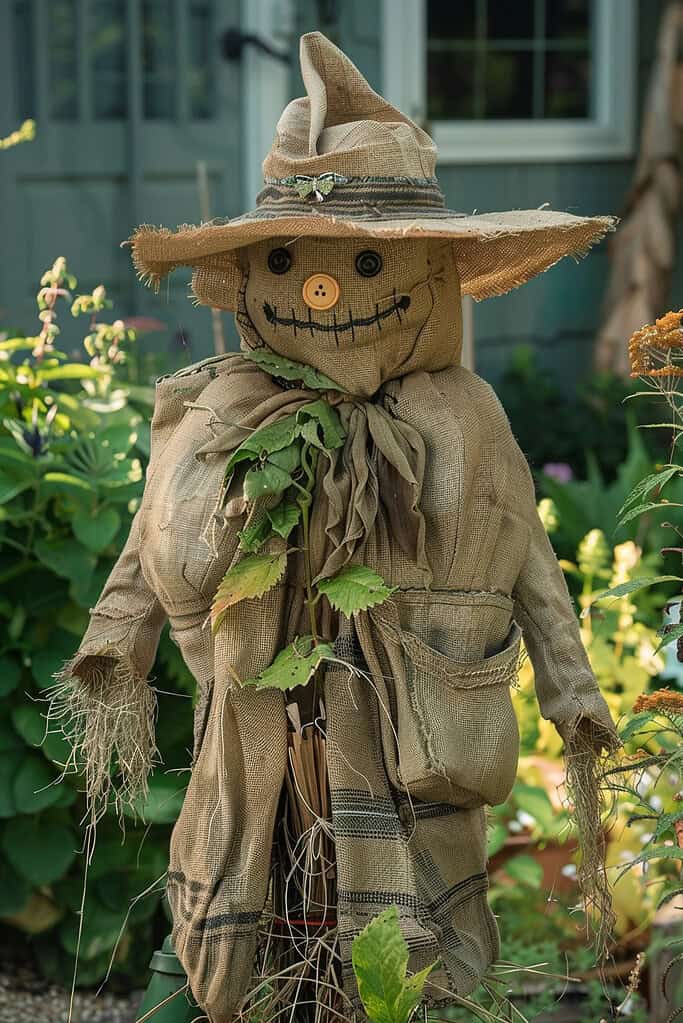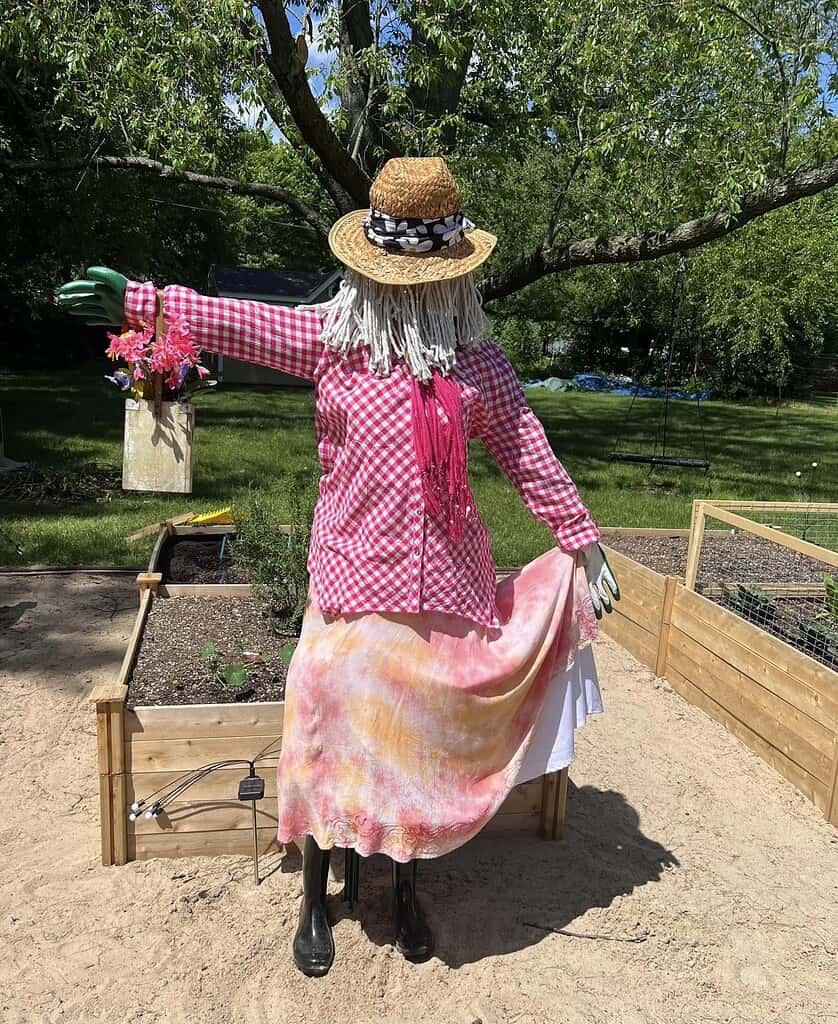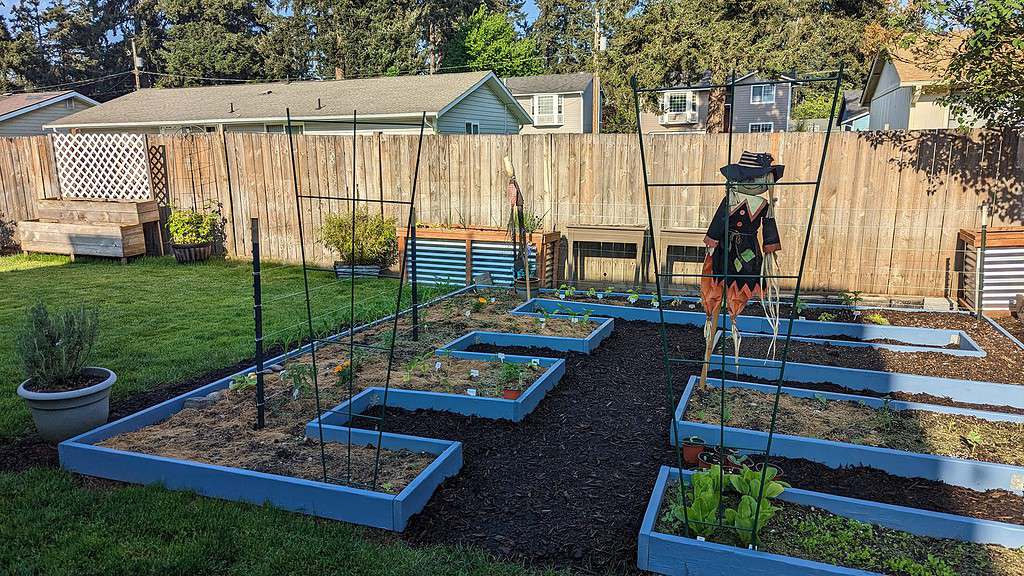Scarecrows have long been used in gardens to keep birds and small animals away from crops. But beyond their practical purpose, they can also add personality and charm to your outdoor space.
From large homestead plots to a few raised beds, a well-placed scarecrow can serve as both a helpful deterrent and a visual centerpiece.
With a few natural or recycled materials (like straw, old clothes, sticks, or garden tools), you can build a figure that suits your space and style.
In this article, you’ll find 13 creative scarecrow ideas made from simple materials. These designs work for gardens of all sizes and offer a mix of practical, decorative, and seasonal styles.
Whether you want something rustic, weather-resistant, or just fun to build, there’s something here for every gardener.
Why Gardeners Use Scarecrows
Birds and small animals are quick to notice changes in the garden – especially when there’s food involved.
Young seedlings, ripening tomatoes, and freshly planted seeds are all targets for pests like crows, pigeons, and squirrels.
Scarecrows act as a simple deterrent by introducing a shape or figure that animals see as a threat, especially when it moves slightly with the wind or includes reflective materials.
While they aren't foolproof, scarecrows can reduce crop damage when positioned well and adjusted occasionally to maintain effectiveness.
Some gardeners add noise elements or shiny decorations to increase their impact.
For those avoiding chemical repellents or traps, a scarecrow offers a low-cost, natural alternative that also blends into the garden environment (and pairs well with other natural pest control solutions).
13 Creative DIY Scarecrow Ideas for Gardens
There’s no single way to make a scarecrow – and that’s what makes it such a practical and creative project.
Depending on what you have available and how you want your garden to look, you can build a scarecrow that’s simple, themed, long-lasting, or just fun to put together.
The following ideas show how to use natural or recycled materials to make scarecrows that fit different garden sizes, styles, and weather conditions.
1. Rustic Straw Scarecrow
This is the most traditional scarecrow style – easy to build and full of that classic country feel. Start with a simple wooden frame or two crossed sticks to shape the body.
Old clothes like a flannel shirt and worn-out jeans work perfectly. Stuff them with straw or hay, making sure to fill the sleeves and legs so they keep their shape.
A burlap sack can be used for the head – just fill it with more straw, tie it off, and draw a simple face with permanent markers or fabric paint.
A straw hat on top helps complete the look and gives some protection to the head if left outdoors.
This kind of scarecrow fits well into vegetable patches and simple homestead garden layouts.
It’s a no-cost project if you have access to straw and some worn clothes and gives your garden a warm, lived-in appearance.
2. Traditional Corn Husk Scarecrow
If you grow corn or have access to dried corn husks, this option puts garden leftovers to good use.
Build a basic wooden frame using scrap lumber or branches, then wrap and tie dry corn husks around the frame using garden twine.
You can layer the husks to give it a natural, textured body. For the head, a burlap sack filled with straw or more husks works well, and you can use bits of husk or dried grass as hair.
This design blends in naturally with late-summer or fall gardens. It also holds up fairly well outdoors and doesn’t require synthetic materials.
If you're aiming for a low-waste or all-natural garden setup, this scarecrow fits right in.
3. Eco-Friendly Bamboo Scarecrow
Bamboo is a strong yet lightweight material, making it ideal for building a scarecrow that’s easy to move and weather-resistant.
Create a simple frame using bamboo poles tied together with natural twine. For stuffing, use what’s on hand – leaves, grass, or straw are all good options.
Instead of a burlap sack, consider using a coconut shell for the head. You can paint a simple face onto the shell with weatherproof paint or markers.
This type of scarecrow suits gardeners who focus on sustainability.
All the materials can be composted or reused, and the structure is sturdy enough to handle wind or rain with minimal damage.
It also has a clean, natural look that fits in well with herb gardens or low-maintenance beds.
4. Seaside Driftwood Scarecrow
This design works well if you live near the coast or just enjoy a beach-themed garden. Collect sturdy pieces of driftwood in various shapes and sizes.
Use rope or strong garden twine to tie them together into a loose figure – one long piece for the body, two for arms, and shorter ones for the legs.
For the head, try using a large, rounded piece of driftwood or even a smooth, sun-bleached rock.
You can leave the wood natural or decorate it with shells, starfish, or other beach finds for extra personality.
This scarecrow has a sculptural look and doesn’t need clothing. It's a good choice for sandy soil areas or gardens with a natural, weathered aesthetic.
Since it uses solid materials, it stands up well to wind and rain.
5. Vintage Rag Scarecrow
For a softer, more nostalgic feel, you can build a scarecrow using fabric scraps, worn-out clothes, and bits of yarn.
Start with a basic wooden or stick frame. Use a burlap sack filled with straw for the body and head, then dress it in faded overalls, an old dress, or other clothing with a well-worn look.
Instead of painting the face, use buttons for eyes, twine for the mouth, and yarn for the hair to give it a hand-stitched charm.
This type of scarecrow fits perfectly in cottage gardens or older homesteads.
It’s more decorative than intimidating, but it still helps deter birds while adding a lived-in, handmade feel to the garden space.
6. Harvest Pumpkin Head Scarecrow
This seasonal scarecrow design is perfect for fall and harvest time. Build the body using old clothes stuffed with straw, leaves, or any dry filler.
Then, instead of a sack for the head, use a real pumpkin. Choose one that’s large and round, then carve a friendly face or paint one on if you prefer to avoid cutting into it.
Place the pumpkin on top of the body and secure it in place. Finish the look with fall accessories like a flannel scarf, corn stalks, or dried flowers.
Since pumpkins eventually decompose, this scarecrow is a short-term display (though if you grow your own, check out our ultimate guide to growing pumpkins for tips).
It's a great option for festivals, fall gardens, or when you want to decorate for a season without building something permanent.
7. Repurposed Wood Pallet Scarecrow
If you have an old wooden pallet lying around, it can be turned into a sturdy and creative scarecrow.
Start by taking apart the pallet with a hammer or pry bar, then use the wood pieces to form a frame – one vertical board for the body, horizontal pieces for the arms, and shorter ones for legs if desired.
You can nail or screw them together or secure with strong twine. For the head, attach a smaller board or round wood piece and paint on a face.
Clothing is optional, but adding a scarf, gloves, or hat gives it more character.
This style is great if you prefer a clean, rustic look without too much fabric or stuffing.
It also holds up well through the seasons and makes use of scrap wood that might otherwise go to waste (much like these creative pallet garden ideas).
8. Gardening Tool Scarecrow
This idea turns worn-out or unused garden tools into a symbolic figure that represents the gardener’s presence. A rake or shovel can serve as the body, with a hoe or trowel attached as arms.
You can use a metal pot or an old watering can for the head – upside down or upright, depending on the shape.
Attach gardening gloves to the ends of the arms, add a sunhat or wide-brimmed straw hat on top, and maybe even wrap a worn apron around the handle for added detail.
This scarecrow works well in vegetable plots and tool sheds, especially if you already have damaged or duplicate tools you don’t use (check out our list of must-have garden tools for the essentials every gardener should keep handy).
9. Sturdy Stone-Based Scarecrow
For windy or exposed areas, a scarecrow built from stone can be a good solution. Stack flat stones or bricks to form the body – three or four layers high.
Choose a round stone for the head and secure it with landscape adhesive if needed.
You can paint a simple face directly onto the surface using outdoor-safe paint. For added character, tie a scarf or belt around the “waist” and place a floppy hat on top of the head.
This scarecrow won’t blow over or rot, and it requires almost no maintenance. While it's more symbolic than lifelike, it adds a grounded, sculptural touch to the garden and can stay up year-round.
10. Simple Burlap Sack Scarecrow
This is one of the easiest scarecrow designs you can make, and it’s great if you want something quick and straightforward.
Start with a large burlap sack and fill it with straw, hay, or dry leaves to form the head and upper body. Tie the sack off at the bottom and attach it to a wooden stake or pole.
For the arms and legs, stuff old clothing with more straw and secure them to the sack using twine or string. You can paint a simple face on the sack or sew on button eyes and a stitched mouth.
This design is ideal for beginner gardeners, quick seasonal decoration, or anyone working with limited time or materials. It’s also lightweight and easy to reposition as needed.
11. Flower Pot Scarecrow
This option uses clay flower pots to create a compact and long-lasting scarecrow that fits well in small gardens, patios, or even on porches.
Use a large pot for the body, placed upright or on its side, and a smaller one on top for the head. If stacking, secure them with waterproof adhesive or wire.
You can draw or paint a face on the smaller pot, and use raffia, straw, or yarn as hair peeking from under a hat. For arms, attach sticks or more pots tied with twine.
Because clay pots are weather-resistant and heavy enough to stay put, this scarecrow lasts longer than many soft-bodied ones and works well in tight spaces where full-size figures might not fit (and if you love clay projects, here’s a DIY method to make ollas for garden watering).
12. Horse Scarecrow
This animal-themed scarecrow takes more effort but becomes a standout feature in any garden. Use a full bale of hay as the body and stack smaller bundles to shape the head and neck.
Attach paper raffia or straw to mimic a mane and tail.
Wooden stakes or PVC pipe can be used inside the hay to give it structure and help it stay upright.
Add details like ears made from cardboard or stiff felt and eyes made from buttons or painted stones.
This design fits especially well in farm or homestead gardens. While not a traditional scarecrow shape, it still serves a decorative and protective function and makes a memorable impression.
13. Mini Scarecrow for Small Gardens
When space is limited – like in raised beds, container gardens, or children’s plots – a mini scarecrow is a practical solution.
Use small sticks or bamboo skewers to create a frame, then dress it with tiny fabric scraps and stuff it lightly with straw or leaves.
A small piece of burlap or a miniature clay pot can be used for the head. Paint or stitch on a small face, and add twine or yarn for simple arms.
These mini scarecrows are quick to make, fun for kids to help with, and just the right size for tight garden spaces. They also work beautifully alongside other creative small garden ideas, adding both charm and function without taking up much room.
While they may not be as intimidating to animals, they still serve as a visual deterrent and decorative accent.
How to Choose the Right Scarecrow Idea for Your Garden
Before deciding which type of scarecrow to build, take a look at your garden space, what materials you already have, and what kind of look you want.
A larger garden might benefit from a full-size scarecrow made of straw or wood, while smaller spaces may only need a compact or decorative option.
If your garden has a theme – like coastal, rustic, or cottage-style – choosing a scarecrow that matches that look can make it feel more intentional.
You’ll also want to think about durability and weather in your area. Materials like stone, driftwood, and sealed clay pots hold up well outdoors, especially in rainy or windy conditions.
On the other hand, if you want something seasonal or temporary, materials like pumpkins or paper-based decorations might work fine for a few weeks.
The best part is that most of these ideas rely on reused or natural materials, so you can choose based on what’s already available around your home, garden, or local environment.
How to Build and Maintain Your Garden Scarecrow
Once you’ve chosen a scarecrow design that fits your garden and materials, it’s time to build it.
Most scarecrows follow the same basic idea – a frame, stuffing (if needed), and outer decorations like clothes or painted features.
But how you secure it and how you care for it will affect how long it lasts and how well it holds up in different weather.
Building Basics
- Frame: Use strong but lightweight materials like wood, bamboo, or sticks. A T-shape frame works for most upright scarecrows. For more complex shapes (like animals), you may need added support inside the body like rebar, PVC pipe, or multiple braces.
- Stuffing: Straw, hay, leaves, or fabric scraps are all good options. These keep the body in shape but also allow airflow, which helps prevent mold in damp weather.
- Head: Burlap sacks, pumpkins, coconut shells, pots, or fabric bundles all work. Secure the head tightly to prevent it from shifting or falling off in wind.
- Clothing: Use older clothing that you don’t mind getting dirty or wet. If you live in a rainy area, look for synthetic fabrics that dry quickly and don’t hold moisture.
- Securing in the ground: For upright scarecrows, drive a wooden stake deep into the soil or anchor the base with rocks or bricks to keep it from tipping. For heavier or permanent scarecrows, dig a shallow hole and fill it with gravel or concrete for added stability.
Maintenance Tips
- Inspect weekly: Check for loose parts, sagging stuffing, or weather damage. Reinforce with twine, nails, or zip ties as needed.
- Protect from moisture: Avoid placing scarecrows in areas with standing water or heavy shade. Mold and mildew can break down fabric and stuffing faster.
- Deter pests more effectively: Add lightweight, moving parts like foil strips, wind chimes, or small mirrors. These help keep birds and animals alert.
- Seasonal updates: Refresh the head or decorations with the seasons. For example, replace a pumpkin head after a few weeks, or dress the scarecrow differently for fall and spring.
- Storage: If you want to reuse the scarecrow each year, remove any perishable items at the end of the season and store the rest in a dry shed or covered space.
Start Building Your Own Scarecrow Using What You Already Have
A scarecrow doesn’t have to be complicated or expensive to be effective.
Whether you build yours from straw, driftwood, garden tools, or even flower pots, the key is using what’s available and making it suit your garden’s size and style.
The 13 ideas shared here show just how flexible and creative this simple tool can be – from classic designs to more decorative or seasonal options.
If you’re growing food or simply want to add a practical, handmade feature to your garden, a scarecrow is a rewarding project that serves both form and function.
Try one out, adjust it over time, and see what works best for your space.
Have you built your own scarecrow before? Or have a favorite idea from the list?
Comment down below – we’d love to hear how you made it work in your garden.
FAQs
What materials are best for building a scarecrow?
Straw, hay, dry leaves, old clothes, and wooden frames are commonly used. Natural and recycled materials are ideal since they’re affordable and blend well into the garden.
Do scarecrows actually keep pests away?
They can help, especially with birds like crows and pigeons. Moving parts, reflective items, or noise makers can improve effectiveness. Changing the scarecrow's position regularly also helps.
How tall should a garden scarecrow be?
Most full-size scarecrows range from 5 to 6 feet tall so they stand at eye level with common birds. Mini scarecrows can be much shorter and work well in raised beds or small gardens.
How long will a scarecrow last outdoors?
It depends on the materials. A straw-filled scarecrow may last a season, while stone or wood-based ones can last all year. Rain and sun exposure will wear down fabrics and stuffing over time.
Can I make a scarecrow without using straw or hay?
Yes, you can use fabric scraps, dry leaves, shredded paper, or even just dress up a wooden or tool-based frame without stuffing it at all.
Ready To Transform Your Garden?
Are you looking for the best way to layout your garden beds? Maybe you're feeling a bit stuck on how to make the most of your space?
We’ve got you covered! Check out our 101+ Garden Bed Layout Ideas for your next raised bed project. This guide is filled with creative and practical ideas that can help you design a garden that fits your style, whether you’re just starting out or have been gardening for years.
Get your copy today and get inspired to bring your gardening dreams to life.



